





Published on Mar 01, 2025
The overture of this work is principally focused on a video analysis based railway-road safety.The recent research of surveillance security systems for road and railway route is Hazard Situations at un expected Level Crossings.In this proposal we initate the AMMFCA with hidden markov model for implementing a smart video surveillance security system that is very much used for detecting and evaluating abnormal and clustering situations induced by pedestrians, vehicle drivers as well as unattended objects.
The experimental design is checked in video surveillance system which is connected to a communication system.ESP8266 wifi controller is used the Wireless Access for Vehicular Environment,which takes the information on the dynamic status of the both safe or presence of a dangerous situation.
Data clustering is the process of dividing data elements into classes or clusters so that items in the same class are as similar as possible, and items in different classes are as dissimilar as possible. Depending on the nature of the data and the purpose for which clustering is being used, different measures of similarity may be used to place items into classes, where the similarity measure controls how the clusters are formed. Some examples of measures that can be used as in clustering include distance, connectivity, and intensity.One of the main goals of computer vision is to enable computers to replicate the basic functions of human vision such as motion perception and scene understanding.
To achieve the goal of intelligent motion perception, much effort has been spent on visual object tracking, which is one of the most important and challenging research topics in computer vision. Essentially, the core of visual object tracking is to robustly estimate the motion state of a target object in each frame of an input image sequence. Considered as a weak point in road and railway infrastructure, improving level crossings (LCs) safety became an important field of academic research and took increasing railway undertaking concerns[1]. Improving the safety of people and road–rail facilities is an essential key element to ensuring good operation of the road and railway transport. Statistically, nearly 44% of LC users have a negative perception of the environment, which consequently increases the risk of accidents[2]. In india for example, several dramatic accidents have occurred in recent years, involving buses with children onboard.
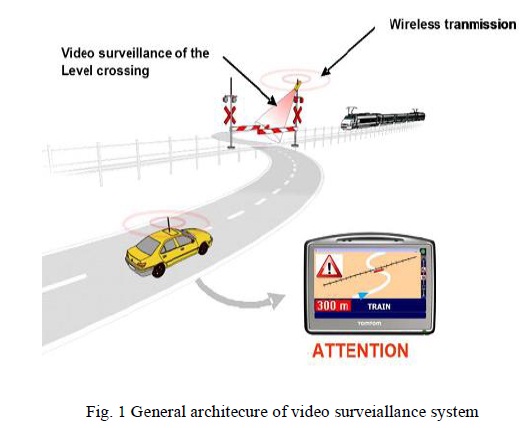
Always, in France, when an accident occurs, the transport operator waits for a road user noticing the accident to use a very old telephone installed at the LC premises to warn the traffic center that something bad is happening at the LC.Then, the operator at the traffic center calls all the approaching trains to tell them to stop immediately without any additional information on what is going on. In the meantime, at the LC level, the situation is becoming worse, because of the wounded users and/or the blocked traffic.
In moving object detection various background subtraction techniques available in the literature were simulated. Background subtraction involves the absolute difference between the current image and the reference updated background over a period of time. A good background subtraction should be able to overcome the problem of varying illumination condition, background clutter, shadows, camouflage, bootstrapping and at the same time motion segmentation of foreground object should be done at the real time. It’s hard to get all these problems solved in one background subtraction technique. So the idea was to simulate and evaluate their performance on various video data taken in complex situations.
Object tracking is a very challenging task in the presence of variability Illumination condition, background motion, complex object shape, partial and full object occlusions. Here in this thesis, modification is done to overcome the problem of illumination variation and background clutter such as fake motion due to the leaves of the trees, water flowing, or flag waving in the wind. Sometimes object tracking involves tracking of a single interested object and that is done using normalized correlation coefficient and updating the template.
On developing a framework to detect moving objects and generate reliable tracks from surveillance video. After setting up a basic system that can serve as a platform for further automatic tracking research, the question of variation in distances between the camera and the objects in different parts of the scene (object depth) in surveillance videos are takled. A feedback-based solution to automatically learn the distance variation in static-camera video scenes is implemented based on object motion in different parts of the scene. It gives more focus towards the investigation of detection and tracking of objects in video surveillance.
The surveillance system is the process of monitoring the behavior, activities or other changing information, usually people for the purpose of influencing, managing, directing, and protecting. Most of the surveillance system includes static camera and fixed background which vies a clue for the object detection in videos by background subtraction technique. In surveillance system three main important steps these are object detection, object tracking and recognition.
Some challenges in video processing Video analysis, video segmentation, video compression, video indexing. In case of video analysis there are three key steps: detection of interesting moving object, tracking of such objects from frame to frame and analysis of objects tracks to recognize their behavior. Next it comes video segmentation it means separation of objects from the background. It also consists of three important steps: object detection, object tracking and object recognition. In this work it is given more focus towards the investigation video analysis and video segmentation section.
A typical automated single camera surveillance system usually consists of three main parts, which can be listed as moving object detection, object tracking and event recognition. In my problem it is to solve an automatic moving target detection and tracking details. The process of automatic tracking of objects begins with the identification of moving objects.
The figure 2 snap is taken from smart city area of coimbatore,tamilnadu,india.Indian Telecom, the national telecommunication services provider successfully connected the country’s first and largest Closed Circuit Television (CCTV) surveillance system through its advanced fibre optic-based Metro Ethernet Network (MEN) infrastructure to improve road safety and national security by providing facilities to authorities of smart city Department to carry out real-time video monitoring, control cameras remotely, record, store and playback .By using this referal we have to start our real time Smart video surveillance security system for Hazard Situations by using adaptive multiobjective memtic fuzzy clustering algorithm.
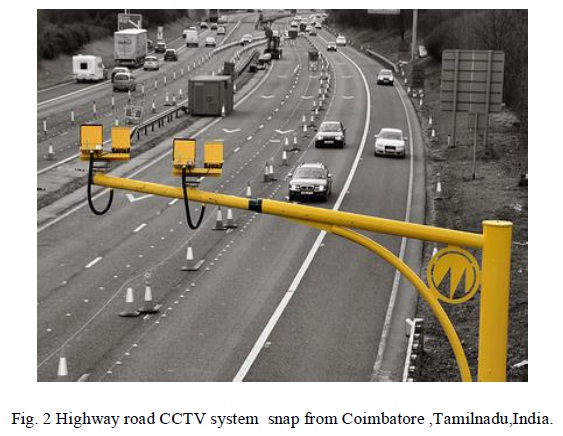
The figure 3 Shows the multi object seperation from the markov hidden model. These approaches examine for the object model in the existing frame. Shape matching performance is similar to the template based tracking in kernel approach. Another approach to Shape matching is to find matching silhouettes detected in two successive frames. Silhouette matching, can be considered similar to point matching. Detection based on Silhouette is carried out by background subtraction. Models object are in the form of density functions, silhouette boundary, object edges. Capable of dealing with single object and Occlusion handling will be performed in with Hough transform techniques.
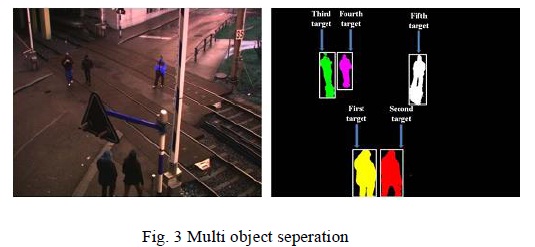
The figure 4 indimate the danger evalutions structure ,.it is refered from Road Safety System for Detecting Hazard Situations at Level . However, these methods need a high number of statistical measures to be accurate[5],[6]. Hence, it is difficult to apply these methods in real time. In this paper, we propose a real-time HMM to predict ideal trajectories of moving objects in an LC environment. Finally, to estimate the degree of danger related to each object, the predicted ideal trajectories are analyzed considering different sources of danger (position, velocity, acceleration, . . .) and using an information fusion framework based on Dempster–Shafer theory
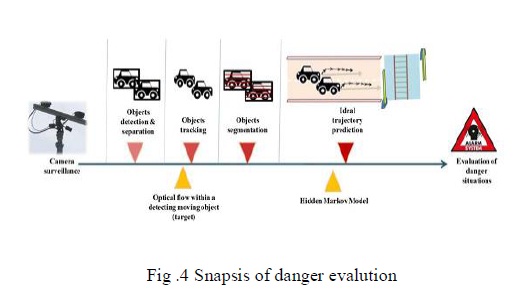
The design of our proposal principly foccused on growing country railway-road safety and secure transportations system. In this we propose a method to improve safety at Level crossings. Here we use kalman filter to predict the persons in the level crossings. By using Gaussian mixture model the person is predicted in the entire process. In the proposed method foreground subtraction is used to identify the persons moving in the level crossings. And the moving persons are tracked in the process .further more we initiate the adaptive memtic fuzzy clustering for same visual detections from hazzard situations ,here we take cloud,all low visiblity obects are hazzard situations.The live video is taken from high quality CCTV camera which is compared from existing vedio files.the motion server is used to detect the pedestrians, vehicle drivers, and unattended objects.
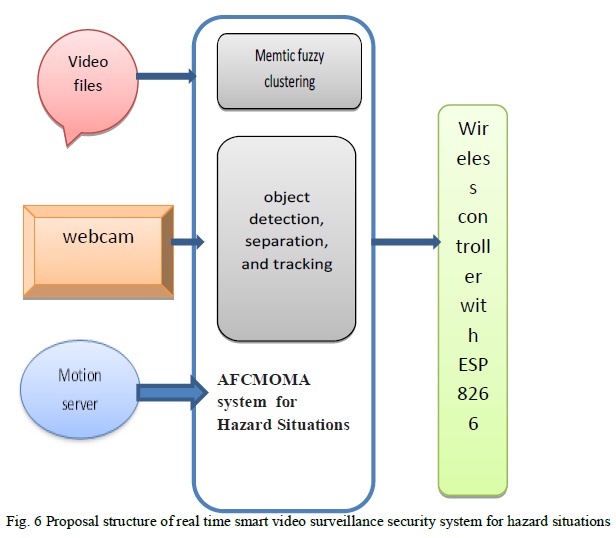
The video surveillance system is connected to a communication system (the Wireless Access for Vehicular Environment), which takes the information on the dynamic status of the LC (safe or presence of a dangerous situation) and sends it to users approaching the LC. Four hazard scenarios are tested and evaluated with different real video image sequences: presence of the obstacle in the LC, presence of the stopped vehicles line, vehicle zigzagging between two closed half barriers, and pedestrian crossing the LC area.In addition, in the multiobjective memetic framework, in order to acquire more individuals with high quality, a new population update strategy is devised, in which the updated population is composed of individuals generated in both the local and global searches of low vissble video frame.Multiobjective clustering algorithms implement the task of clustering through a multiobjective optimization technique,the goal of which is to generate a set of cluster centers by simultaneously minimizing or maximizing multiple objective functions.finally the result is given to the wifi module which is developed by using ESP8266.
In this proposal we focussed and designed an efficient smart video surveillance security system for Hazard Situations at level crossing in transportation route..We majorly consider this design for growing country railway-road safety system such as india,pakistan.The experimental design is based on fall of a pedestrian and unattended objects in level crossing .We used an adaptive multiobjective memetic fuzzy clustering algorithm with hidden markovian models were used for the hazzard situation at level crossing.Finally the proposal design is checked by the matlab 13v and vissual studios.For our future enhancement the designed result will be check with wifi communications system.The proposal structure figure 6 is mentioning of our future enhancement work.We hope our experimental result will be work on real time road safety system in growing countries.
[1] Houssam Salmane ―A Video-Analysis-Based Railway–Road Safety System for Detecting Hazard Situations at Level Crossings‖ Houssam Salmane IEEE TRANSACTIONS ON INTELLIGENT TRANSPORTATION SYSTEMS 2015.
[2] E. Griffioen, ―Improving level crossings using findings from human behaviour studies,‖ in Proc. 8th Int. Level Crossing Symp., Sheffield, U.K.,2004.
[3] [Online].Available:http://www.uic.org/cdrom/2008/11_wcrr2008/pdf/G.2.4.5.4.pdf
[4] L. Khoudour, M. Ghazel, F. Boukour, M. Heddebaut, and M. El-Koursi,―Towards safer level crossings: Existing recommendations, new applicable technologies and a proposed simulation model,‖ Eur. Transp. Res.Rev., vol. 1, no. 1, pp. 35–45, Mar. 2009.
[5] J. J. Garcia et al., ―Efficient multisensory barrier for obstacle detection onrailways,‖ IEEE Trans. Intell. Transp. Syst., vol. 11, no. 3, pp. 702–713,Sep. 2010.